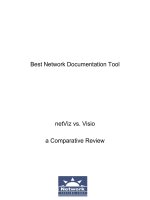Tài liệu Performance Appraisals doc
Bạn đang xem bản rút gọn của tài liệu. Xem và tải ngay bản đầy đủ của tài liệu tại đây (120.71 KB, 9 trang )
Performance Appraisals –
How to Make Them
Work For You
1-800-COURSES
www.globalknowledge.com
Expert Reference Series of White Papers
Introduction
Performance Appraisals. Two words that can make the hair stand on end for both employees
and managers.
Poorly done, performance appraisals can leave you with underperformers who lack the direc-
tion to change their behavior, good performers who feel unrecognized for their work, and,
worse yet, problem employees who should be dismissed, but a lack of appropriate documenta-
tion prevents this.
Performance appraisals can be a rewarding experience for both the employee and employer if
the appraisals are carefully planned, geared toward the right objectives, and form part of an
ongoing process aimed at continual performance improvement.
Purpose of Performance Appraisals
Performance appraisals provide a review of how well employees are able to meet expectations.
Most organizations have a general idea of what target performance looks like but fail when it
comes to communicating this target.
Imagine your job is to sell tires and you sell more than anyone else. You rule! What if you did
not know that management expects you to concentrate on selling the more expensive brands,
that something about your work behavior alienates your colleagues, and that your lack of
attention to detail and paperwork creates confusion for other people? But you did sell the most
tires, so what’s the problem?
Employees need a detailed plan to show them how to succeed at their jobs. They need specif-
ic targets in all areas of responsibility and they need to know where they stand at any given
time.
There are three reasons why employers need to use performance appraisals.
1. To set performance standards and, in some companies, form the basis of a reward system.
2. To form the basis of a coaching plan.
3. To document poor performance as part of a dismissal process.
Steve Lemmex, Global Knowledge Course Director, PMP
Performance Appraisals –
How to Make Them Work For You
Copyright ©2005 Global Knowledge Network, Inc. All rights reserved.
Page 2
Part 1: Preparing for the Appraisal
Collecting Background Information
One of the most difficult aspects of conducting the performance appraisal is substantiating the
performance of an employee, whether positive or negative. Unless you have a consistent,
organized method of collecting information, the performance appraisal will usually be based on
recent incidents or those that stand out in your mind. This will provide an unfair evaluation of
performance.
In order to collect information on employee performance, you must look to several sources:
Incident Reports/Praise
An incident report should be used to collect both negative and positive feedback from col-
leagues, management, and the employee’s peers. These reports should provide the basic
details, the context in which the incident happened, the date and time, and what was done
about it.
When performance appraisal time rolls around, these incidents will form the basis of their
appraisal. There should be no surprises to the employee! With continual communication, they
should always know how well they are performing.
Incident reports could include:
• comments from peers, other supervisors, or management
• comments from customers
• examples of work performed
• how the employee handled difficult situations
• positive and negative examples of work behavior
Job Description
The job description is a key element for preparing a performance appraisal because it captures
the job responsibilities and expected behaviors. Make available to the employee changes to a
job description as soon as they are approved.
Previous Evaluations
It is a good idea to review previous evaluations to see past performance; however, you must
be careful not to rely too heavily on these documents. Previous evaluations can influence your
opinion whether they were written by you or by a previous supervisor.
Employee Self-Assessment
You might think that giving employees the chance to self-assess their performance is simply an
opportunity for them to show how wonderful they think they are, but you would be surprised at
what they reveal. Employees should be given the performance appraisal form and an explana-
tion of its scale and be asked to evaluate themselves on each of the criteria. They will need to
provide some detail to justify the evaluation they have given themselves.
Copyright ©2005 Global Knowledge Network, Inc. All rights reserved.
Page 3
The supervisor will be able to spot discrepancies between his or her evaluation and the
employee’s and be prepared to discuss them. The employee should be asked to comment on:
• any accomplishments or training they have taken during the current review period (includ-
ing on-the-job training)
• career aspirations
• factors that have impacted their ability to perform (both positive and negative)
• how they feel that the department can be improved
• how they feel they are being managed
Preparing the Appraisal
The most important point when preparing an appraisal is that it must be done on an objective
basis. Objective factors are those that are easily measurable and tangible, such as atten-
dance, production rates, quality, response rates, and accuracy. Avoid subjective factors such
as attitudes, personality, adaptability, and opinions, since they cannot be defended.
You must assess job performance – not personality! If you dislike an employee, it is easy to
veer off-track and focus on personal characteristics instead of job performance. Although his or
her personality may be a factor in poor performance, do not assume it. Make sure that your
objective observations prove it.
While filling out the appraisal form, first write the comments for each piece of criteria that sub-
stantiates the employee’s performance. Stick to observable, verifiable facts, not opinions. Once
that is done, choose the appropriate value from the scale indicating performance. Done in this
order, you are rating on detailed observations, not simply picking a value and substantiating it.
(This really makes a difference!)
Next, review your comments and make sure they do not contain inflammatory statements.
Confirm that you were objective in your evaluation.
In many organizations, the draft appraisal would be shown to your manager prior to reviewing
it with the employee. The draft appraisal should be given to the employee to review and pre-
pare comments prior to your meeting. Remember – no surprises!
Now have the employee compile his or her self-assessment. It is important to know how they
feel they are performing. This gives will alert you to the points you will need to concentrate on
in your upcoming discussion. The employee’s self-assessment should be delivered to you with
plenty of time for you to review it before the performance appraisal meeting.
Part 2:Administering the Appraisal
Conducting the Actual Performance Appraisal Meeting
This part of the process can be intimidating for the employee and uncomfortable for the super-
visor. Having thorough documentation to back up the comments on the appraisal will make it
less emotional and more professional.
Schedule sufficient time to discuss the appraisal. Do not rush! Employees need to feel that this
is important to you and worthy of your time.
Copyright ©2005 Global Knowledge Network, Inc. All rights reserved.
Page 4
Start by explaining how you compiled the appraisal. Make sure that they know this is not just
your opinion but a comparison of expected performance and observed behavior.
Be prepared to defend your comments and ratings. You should have your documented facts
available to review. Remain flexible, and listen carefully to their comments.
If you get to a point where you cannot agree, you need to agree to disagree and move on. You
are the supervisor and it is your responsibility to complete the appraisal.
Meeting Tips
• Use behavioral examples to maintain an objective demeanor – instead of saying “you are
impatient,” give examples that demonstrate the behavior, such as “you do not let people
finish what they are saying,” or “you do not give reasonable deadlines for projects.”
• Suggest alternate positive behavior – once you tell them what you don’t like, make sure
that they know what behavior you expect.
• Provide positive reinforcement – do not focus only on the negative aspects of their per-
formance appraisal; make sure to emphasize the positive as well.
• Encourage two-way conversation – use open-ended questions to draw out their opinions
during the meeting. Avoid questions like “are you happy with this evaluation?” Instead,
draw out their thoughts with questions such as “How do you feel I have evaluated your
performance?”
• Respect the employee’s self-esteem – it can be difficult to discuss weaknesses and many
employees may get defensive. Provide positive support by showing them you are willing
to work with them in their efforts to succeed.
• Don’t guess at their motives – ask. Hopefully the conversation will reveal the motives for
their behavior.
You’re Not Done Yet!
Once past performance has been completed, it is time to determine the next steps. Employees
who have met or exceeded their performance objectives will need a development plan that
continues to encourage this good behavior. Poor performers will need their development plan
geared toward achieving their performance objectives. Once the development plan has been
sketched out, it will be time to set the performance objectives.
Create a Development Plan
The development plan can be used to prepare a top performer to advance to another level in
the organization and take on additional responsibilities. It can also be used to provide the
underachieving employee with the skills to perform to the expected level.
The development plan should outline specific tasks and activities to be undertaken over a
given time period: six months to one year in most companies.
Copyright ©2005 Global Knowledge Network, Inc. All rights reserved.
Page 5









